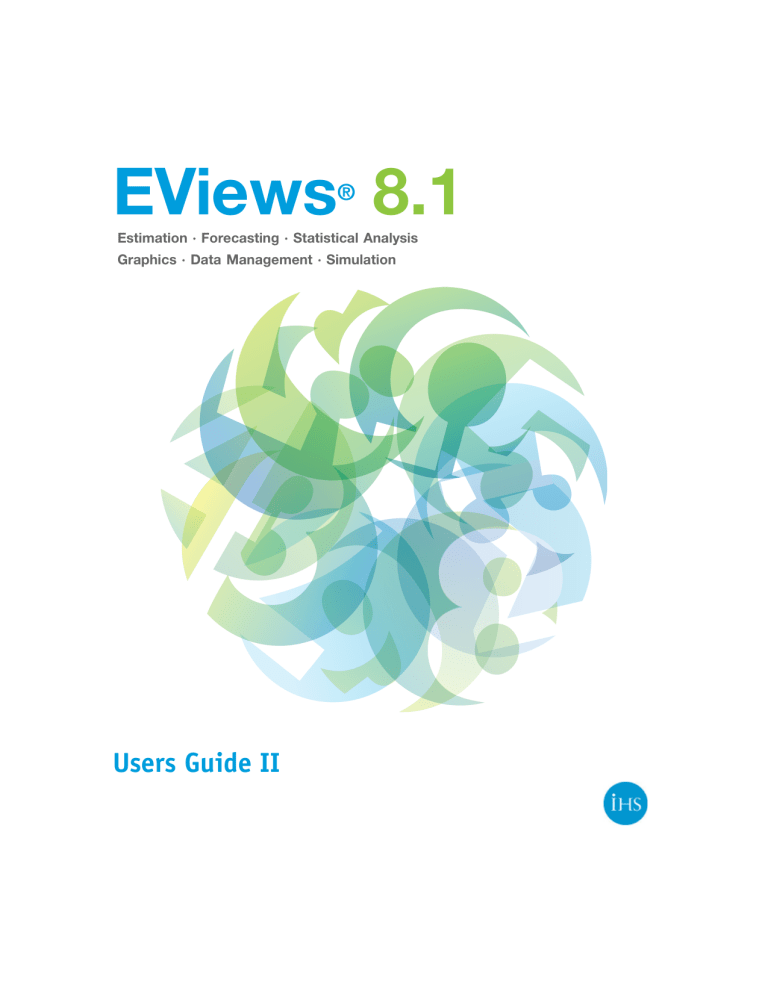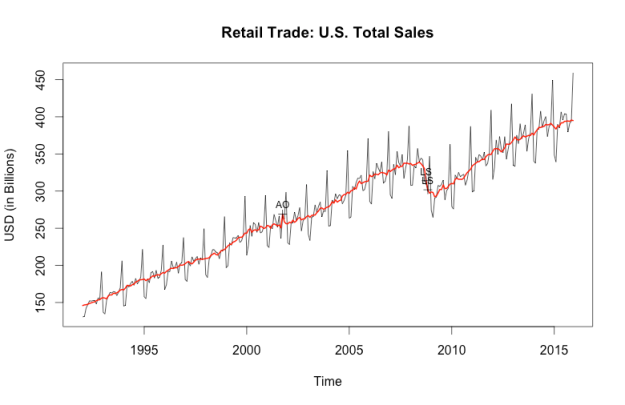| Developer(s) | U.S. Census Bureau |
|---|---|
| Stable release | |
| Repository | |
| Operating system | Windows, Linux/Unix |
| Type | Statistical software |
| License | Public domain[1][2] |
| Website | www.census.gov/data/software/x13as.html |
X-13ARIMA-SEATS, successor to X-12-ARIMA and X-11, is a set of statistical methods for seasonal adjustment and other descriptive analysis of time series data that are implemented in the U.S. Census Bureau's software package.[3] These methods are or have been used by Statistics Canada, Australian Bureau of Statistics, and the statistical offices of many other countries.[4][5]
X-12-ARIMA can be used together with many statistical packages, such as SAS in its econometric and time series (ETS) package, R in its (seasonal) package,[6]Gretl or EViews which provides a graphical user interface for X-12-ARIMA, and NumXL which avails X-12-ARIMA functionality in Microsoft Excel.[7] There is also a version for Matlab.[8]
Notable statistical agencies presently using X-12-ARIMA for seasonal adjustment include Statistics Canada,[9] the U.S. Bureau of Labor Statistics[10] and Census and Statistics Department (Hong Kong).[11] The Brazilian Institute of Geography and Statistics uses X-13-ARIMA.[12]
- X13binary: X-13ARIMA-SEATS Binary for R. This package provides an installer for R to access prebuilt binaries of X-13ARIMA-SEATS from the sibbling repository x13prebuilt. This allows for fully automated installation of a X-13ARIMA-SEATS binary simply by adding Depends: x13binary to your R package.
- Latent Class Probabilistic Latent Feature Analysis of Three-Way Three-Mode Binary Data: PDF. Seasonal Adjustment by X-13ARIMA-SEATS in R: PDF: Christoph Sax, Dirk.
A substantial part of the output of X-13ARIMA-SEATS can be shown on the website. Click and drag to zoom into the graph. Double click to restore the original view. Manipulating the R-Call. The R-Call to seasonal can be modified and run online. In the picture below, the ARIMA model has been adjusted to include an autoregressive parameter of order 2. X-13ARIMA-SEATS Binary for R. This package provides an installer for R to access prebuilt binaries of X-13ARIMA-SEATS from the sibbling repository x13prebuilt. This allows for fully automated installation of a X-13ARIMA-SEATS binary simply by adding Depends: x13binary to your R.
X-12-ARIMA was the successor to X-11-ARIMA; the current version is X-13ARIMA-SEATS.[13]
X-13-ARIMA-SEATS's source code can be found on the Census Bureau's website.[14]
Methods[edit]
The default method for seasonal adjustment is based on the X-11 algorithm. It is assumed that the observations in a time series, , can be decomposed additively,
or multiplicatively,
In this decomposition, is the trend (or the 'trend cycle' because it also includes cyclical movements such as business cycles) component, is the seasonal component, and is the irregular (or random) component. The goal is to estimate each of the three components and then remove the seasonal component from the time series, producing a seasonally adjusted time series.[15]
The decomposition is accomplished through the iterative application of centered moving averages. For an additive decomposition of a monthly time series, for example, the algorithm follows the following pattern:
- An initial estimate of the trend is obtained by calculating centered moving averages for 13 observations (from to ).
- Subtract the initial estimate of the trend series from the original series, leaving the seasonal and irregular components (SI).
- Calculate an initial estimate of the seasonal component using a centered moving average of the SI series at seasonal frequencies, such as
- Calculate an initial seasonally adjusted series by subtracting the initial seasonal component from the original series.
- Calculate another estimate of the trend using a different set of weights (known as 'Henderson weights').
- Remove the trend again and calculate another estimate of the seasonal factor.
- Seasonally adjust the series again with the new seasonal factors.
- Calculate the final trend and irregular components from the seasonally adjusted series.
The method also includes a number of tests, diagnostics and other statistics for evaluating the quality of the seasonal adjustments.
See also[edit]

References[edit]
- ^https://www.census.gov/srd/www/x13as/x13down_unix.html
- ^https://www.census.gov/srd/www/disclaimer.html
- ^'X-13ARIMA-SEATS Seasonal Adjustment Program'. United States Census Bureau. Retrieved March 24, 2021.
- ^'Time Series Analysis: Seasonal Adjustment Methods'. November 14, 2005.
- ^Susie Fortier and Guy Gellatly. 'Seasonally adjusted data – Frequently asked questions'. Retrieved March 24, 2021.CS1 maint: uses authors parameter (link)
- ^'seasonal: R Interface to X-13-ARIMA-SEATS version 1.8.2 from CRAN'. rdrr.io. Retrieved 2021-05-25.
- ^'Implementation of the X-11 Seasonal Adjustment Method'.
- ^'X-13 Toolbox for Seasonal Filtering'. www.mathworks.com. Retrieved 2021-05-25.
- ^http://www.statcan.gc.ca/pub/12-539-x/2009001/seasonal-saisonnal-eng.htm
- ^http://www.bls.gov/cpi/cpisahoma.htm
- ^https://www.censtatd.gov.hk/hkstat/sub/sc30.jsp
- ^ftp://ftp.ibge.gov.br/Contas_Nacionais/Contas_Nacionais_Trimestrais/Ajuste_Sazonal/X13_NasContasTrimestrais.pdf
- ^https://www.census.gov/srd/www/x13as/
- ^https://www.census.gov/srd/www/x13as/x13down_unix.html
- ^Findley, David F.; Monsell, Brian C.; Bell, William R.; Otto, Mark C.; Chen, Bor-Chung (1998), 'New Capabilities and Methods of the X-12-ARIMA Seasonal Adjustment Program'(PDF), Journal of Business and Economic Statistics, 16
External links[edit]
X-13arima-seats
x13binary: X-13ARIMA-SEATS Binary for R
About
This package provides an installer for R toaccess prebuilt binaries of X-13ARIMA-SEATS from the sibblingrepository x13prebuilt. This allowsfor fully automated installation of aX-13ARIMA-SEATS binary simply byadding Depends: x13binary to your R package.
X-13arima

Installation
As the package is on CRAN,the usual procedure applies:
Status
This package as well as the correspondingx13prebuilt repository areoperational for Windows, OS X (Darwin) and Linux (via using statically linkedbinaries).

The current version of x13binary usesversion 1.1, build 39 of of X-13, as can be verified by:
Author
Dirk Eddelbuettel and Christoph Sax
License
GPL (>= 2)